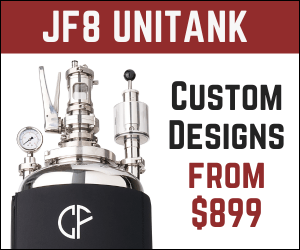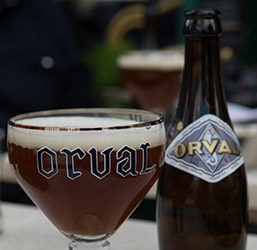Dubbel Halo Ale
Dubbel Halo Ale
(5 gallons/19 L, extract only)
OG = 1.064 FG = 1.011–1.012
IBU = 20 SRM = 15 ABV = 6.5%
Ingredients
5.7 lbs. (2.6 kg) pale liquid malt extract
1.8 lbs. (0.82 kg) dark liquid malt extract
0.5 lbs. (0.23 kg) table sugar (sucrose)
0.5 lbs. (0.23 kg) corn sugar (glucose)
5.6 AAU Styrian Goldings hops (bittering) (0.8 oz./23 g of 7% alpha acid)
0.5 oz. (14 g) Saaz hops (flavor)
0.5 oz. (14 g) Tettnanger hops (aroma)
1 tsp. Irish moss
Wyeast 1388 (Belgian Strong Ale) or White Labs WLP500 (Trappist Ale) (primary fermentation)
Wyeast 1762 (Belgian Abbey II) or White Labs WLP530 (Abbey) (conditioning)
1 cup DME or corn sugar (for priming)
Step by Step
Mix the malt extracts with your hot brewing water in the kettle and bring the wort to a boil and add the bittering hops immediately. Boil for one hour. Add the bittering hops immediately and boil for one hour. Add the flavor hops and Irish moss about 15 minutes before shutdown. Add the aroma hops (for the Dubbel only) directly at shutdown. Then follow the all-grain instructions for cooling, fermenting, conditioning and packaging the brew.
Dubbel Halo Ale
(5 gallons/19 L, all grain)
OG = 1.064 FG = 1.011
IBU = 20 SRM = 15 ABV = 6.6%
Ingredients
10.75 lbs. (4.9 kg) pale 2-row Pils malt
0.5 lb. (0.22 kg) crystal malt (120 °L)
0.5 lbs. (0.23 kg) table sugar (sucrose)
0.5 lbs. (0.23 kg) corn sugar (glucose)
5.6 AAU Styrian Goldings hops (bittering) (0.8 oz./23 g of 7% alpha acid)
0.5 oz. (14 g) Saaz hops (flavor)
0.5 oz. (14 g) Tettnanger hops (aroma)
1 tsp. Irish moss
Wyeast 1388 (Belgian Strong Ale) or White Labs WLP500 (Trappist Ale) (primary fermentation)
Wyeast 1762 (Belgian Abbey II) or White Labs WLP530 (Abbey) (conditioning)
1 cup table or corn sugar (for priming)
Step by Step
The grain bill for this brew and the resulting color values have been calculated for a system with a hypothetical extract efficiency of roughly 65%. One pound of sugar is assumed to contribute about 10 to 13 gravity points to 5 gallons of wort. Depending on your actual results, you may have to liquor down your wort at the end of the boil to achieve the specified target original gravity.
Use a single-infusion process with a 90-minute rest at roughly 152 °F (66 °C). Then sparge with about 180 °F (82 °C) water for about 75 minutes. Make sure that the mash temperature at the end of the sparge has reached 168–170 °F (76–77 °C).
Boil your wort for 90 minutes. Add the bittering hops about 30 minutes into the boil. Add the flavor hops and Irish moss about 15 minutes before shutdown. Add the aroma hops (for the dubbel only) directly at shutdown.
Heat-exchange the wort to 68 °F (20 °C) and aerate. Because Trappist brews have a relatively high starting gravity, it is a good idea for a healthy cell count to pitch two packages of either the Wyeast 1388 or the WLP500. Alternatively you can use just one package of yeast and save money by making a yeast starter. Rack the brew off its debris after about two weeks. Then keep it undisturbed for another two to three weeks. Rack the beer again and prime it with sugar. At this point, to aid in bottle conditioning, add the remaining package of yeast. This yeast ought to be fairly alcohol-tolerant (such as Wyeast 1762 or WLP530). Package immediately after priming and inoculating.
The Wyeast 1388 performs best at a temperature of 65–75 °F (18–24 °C), the WLP500 at 65–70 °F (18–21 °C), the Wyeast 1762 at 65–75 °F (18–24 °C), and the WLP530 at 66–72 °F (19–22 °C). So regardless of your choice of yeast, you are safe if you keep both your fermentation and your conditioning temperature constant at around 68 °F (20 °C). You can start tasting the beer after about a month, but it will get much better after a conditioning rest of about half a year.
Written by Horst Dornbusch

Horst Dornbusch lays out a recipe with fermentation tips for those looking to brew up a Belgian Dubbel.



